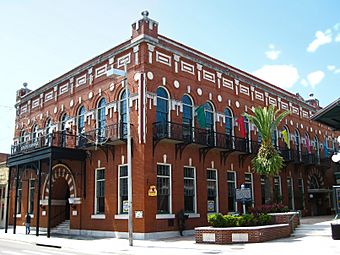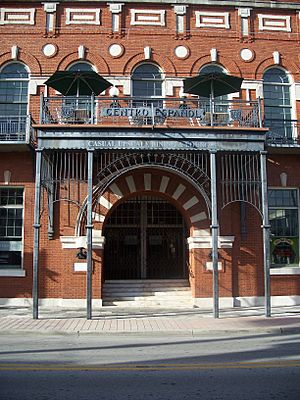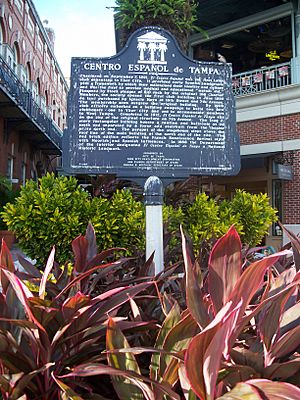El Centro Español de Tampa facts for kids
For the similarly named building in West Tampa see El Centro Español of West Tampa
|
El Centro Español de Tampa
|
|
|
U.S. National Historic Landmark District
Contributing Property |
|

El Centro Español de Tampa, 7th Avenue, Ybor City.
|
|
| Location | 1526–1536 East 7th Avenue Tampa, Florida, US |
|---|---|
| Area | 1 acre (0.40 ha) |
| Built | 1912 |
| Architect | Francis J. Kennard |
| Architectural style | French Renaissance Revival with Moorish and Spanish influences |
| Part of | Ybor City Historic District (ID74000641) |
| NRHP reference No. | 88001823 |
Quick facts for kids Significant dates |
|
| Added to NRHP | June 3, 1988 |
| Designated NHL | June 3, 1988 |
| Designated NHLDCP | December 4, 1990 |
El Centro Español de Tampa is a very old and important building in the Ybor City area of Tampa, Florida. It was built in 1912 as a special club for people from Spain. This red brick building is located at 1526–1536 East 7th Avenue. Today, it's part of a shopping and fun area.
This building is one of the few left that shows the history of Spanish people moving to the United States in the late 1800s and early 1900s. Because of its special history, El Centro Español became a U.S. National Historic Landmark (NHL) on June 3, 1988. This means it's a place recognized as super important to the history of the whole country. It's one of only two buildings in Hillsborough County with this special title.
Even before it became a National Historic Landmark, people knew El Centro Español was important. In 1974, it was listed as a key building in the Ybor City Historic District. This whole district became a National Historic Landmark District on December 4, 1990. Today, the building is home to a restaurant called Carne.
Discovering the History of El Centro Español
In 1891, people who moved from Spain (some came through Cuba) to the busy factory town of Ybor City started El Centro Español. It was the first of many social clubs and mutual aid societies for different groups of people. El Centro Español was a model for other clubs that came later, like El Centro Asturiano and El Circulo Cubano.
These clubs were very important in Ybor City. They helped new people who had just arrived feel welcome and get settled. For a small membership fee, members got more than just fun social events. They also received education programs and even health care. In 1904, El Centro Español built its own hospital, called Sanatorio del Centro Español. At that time, it was one of the best hospitals in Florida!
The club's first building was fancy, with two towers. It was built in 1892 where the current building stands. It had a theater, a dance hall, a snack bar, and classrooms where people could learn English. The club grew very fast, with over 2,600 members by 1908. Soon, they needed a bigger place. So, they replaced their first clubhouse with the building we see today in 1912. That same year, they opened a second club, El Centro Español de West Tampa, for Spanish people living in West Tampa.
After many good years, El Centro Español and other clubs started to face challenges. Things like Prohibition (when alcohol was illegal), the Great Depression (a time of economic hardship), and new rules about immigration meant fewer new members. Many people also moved away to find work. By World War II, the government and private groups started to offer the health care and social help that the clubs used to provide. Also, as Spanish-American families lived in the U.S. for generations, they mixed more with other cultures. This meant fewer people joined the clubs.
In 1983, the club moved all its remaining members to the West Tampa clubhouse. The original El Centro Español de Tampa building was sold. It was empty for a few years, but it was fixed up in 2010. Now, it's home to a restaurant. The West Tampa clubhouse is now used by The Hillsborough Education Foundation for its Teaching Tools for Hillsborough Schools program.
Exploring the Architecture of El Centro Español
The Centro Español building was designed by Francis J. Kennard. He was an architect who designed many important buildings in the Tampa Bay area. Some of his other famous works include Hillsborough High School and St. Andrews Episcopal Church.
Kennard designed El Centro Español in a style called French Renaissance Revival. This style looks back to the grand buildings of the Renaissance period. He also added strong influences from Moorish Revival and Spanish Mediterranean Revival styles. This mix of styles makes the building very unique and beautiful.
The building is made of red brick with white stone details. It has a basic rectangular shape. The main part of the building is two and a half stories tall. There's also a wing at the back that is three and a half stories tall. The front of the building, facing 7th Avenue, has a main entrance with an arch in the Moorish style. It also has fancy cast-iron decorations. The long side of the building, facing east, looks like a grand palace. This is a common feature in Renaissance Revival designs. This side also has cast-iron balconies.
See also
 In Spanish: Centro Español de Tampa para niños
In Spanish: Centro Español de Tampa para niños





